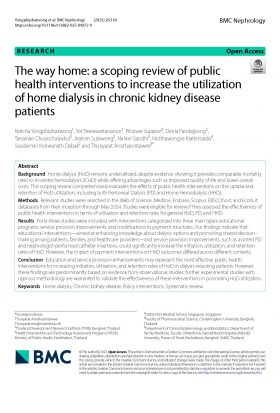This website uses cookies so that we can provide you with the best user experience possible. Cookie information is stored in your browser and performs functions such as recognising you when you return to our website and helping our team to understand which sections of the website you find most interesting and useful.
The way home: a scoping review of public health interventions to increase the utilization of home dialysis in chronic kidney disease patients

รายละเอียดเพิ่มเติม
Abstract
Background
Home dialysis (HoD) remains underutilized, despite evidence showing it provides comparable mortality rates to in-center hemodialysis (ICHD) while offering advantages such as improved quality of life and lower overall costs. This scoping review comprehensively evaluates the effects of public health interventions on the uptake and retention of HoD utilization, including both Peritoneal Dialysis (PD) and Home Hemodialysis (HHD).
Methods
Relevant studies were searched in the Web of Science, Medline, Embase, Scopus, EBSCOhost, and EconLit databases from their inception through May 2024. Studies were eligible for review if they assessed the effectiveness of public health interventions in terms of utilization and retention rates for general HoD, PD, and HHD.
Results
Forty-three studies were included, with interventions categorized into three main types: educational programs, service provision improvements, and modifications to payment structures. Our findings indicate that educational interventions—aimed at enhancing knowledge about dialysis options and promoting shared decision-making among patients, families, and healthcare providers—and service provision improvements, such as assisted PD and nephrologist-performed catheter insertions, could significantly increase the initiation, utilization, and retention rates of HoD. However, the impact of payment interventions on HoD outcomes differed across different contexts.
Conclusion
Education and service provision enhancements may represent the most effective public health interventions for increasing initiation, utilization, and retention rates of HoD in dialysis-requiring patients. However, these findings are predominantly based on evidence from observational studies; further experimental studies with rigorous methodology are warranted to validate the effectiveness of these interventions in promoting HoD utilization.
Original source: https://bmcnephrol.biomedcentral.com/articles/10.1186/s12882-025-04072-9




